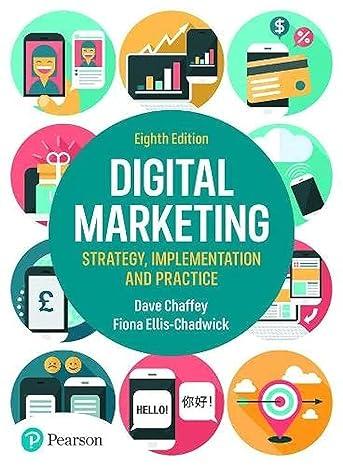Why a case study on Amazon? Surely everyone knows about Amazon and what it does? Yes, well,
Question:
Why a case study on Amazon? Surely everyone knows about Amazon and what it does? Yes, well, that’s maybe true, but this case goes under the surface to review some of the ‘insider secrets’ of Amazon’s early success and its focus on customers, measurement and improvement that remain in place today even though its original founder is no longer in place.
Amazon.com was launched in 1995. The name reflected the vision of founder and CEO Jeff Bezos, to produce a large-scale phenomenon like the Amazon river. This ambition proved justified since, just eight years later, Amazon passed the $5 billion sales mark – it took Walmart 20 years to achieve this. In 2020 turnover exceeded $21 billion excluding third-party seller profits via the Amazon Marketplace, which were estimated at $25 billion. In the final letter to shareholders from Jeff Bezos (Amazon, 2021) before Andy Jassy became CEO, he summarises the scale and impact of Amazon, emphasising not the turnover but services launched and how they directly affect many people’s lives:
Amazon directly employs 1.3 million people around the world. We have more than 200 million Prime members worldwide. More than 1.9 million small and medium-sized businesses sell in our store, and they make up close to 60% of our retail sales. Customers have connected more than 100 million smart home devices to Alexa. Amazon Web Services serves millions of customers and ended 2020 with a $50 billion annualized run rate.
Vision, value proposition and strategy
When it first launched, Amazon had a clear and ambitious mission:
We seek to be Earth’s most customer-centric company for four primary customer sets: consumers, sellers, enterprises, and content creators.
In 2021, Bezos summarised Amazon’s consumer offer as ‘low prices, vast selection, and fast delivery’. He also stresses the value of convenience, which has led to loyalty.
He notes that customers complete 28 per cent of purchases on Amazon in three minutes or less, and half of all purchases are finished in less than 15 minutes. He contrasts that to the typical shopping trip to a physical store – driving, parking, searching store aisles, waiting in the checkout line, finding your car and driving home.
This measure of purchase efficiency is clearly a hurdlerate measure that Amazon uses and looks to improve upon.
Today, with business users of its Amazon Web Services representing a new type of customer, Amazon says:
this goal continues today, but Amazon’s customers are worldwide now and have grown to include millions of Consumers, Sellers, Content Creators, Developers, and Enterprises. Each of these groups has different needs, and we always work to meet those needs, by innovating new solutions to make things easier, faster, better, and more cost-effective.
This focus on the customer has been there from the start:
the 1997 SEC filing said Amazon would ‘obsess over the customer’. Success here is shown by consistently high ratings at the American Customer Satisfaction Index (www.theacsi.org). In the 2017 Annual Report, Jeff Bezos explains what he calls ‘True Customer Obsession’ (Amazon, 2017):
There are many ways to center a business. You can be competitor focused, you can be product focused, you can be technology focused, you can be business model focused, and there are more. But in my view, obsessive customer focus is by far the most important.
Even when they don’t yet know it, customers want something better, and your desire to delight customers will drive you to invent on their behalf.
In each SEC (Securities and Exchange Commission)
filing, Amazon explains how it uses an analytical approach to improve satisfaction and business performance by reiterating a comment in a letter to shareholders from Jeff Bezos when Amazon first became a publicly quoted company:
We will continue to measure our programs and the effectiveness of our investments analytically, to jettison those that do not provide acceptable returns, and to step up our investment in those that work best.
We will continue to learn from both our successes and our failures.
More recently, this approach has been applied to a range of business model innovations focused on hardware and new services: Kindle e-reader, Fire tablet, smartphone and TV, Echo (using the Alexa artificial intelligence voice assistant), grocery delivery, Amazon Fashion and expansion to the business-oriented Amazon Web Services (AWS). Amazon Prime is the annual membership programme that includes unlimited free shipping and then involved diversification to a media service with access to unlimited instant streaming of thousands of movies and TV episodes..........
Questions
1 By referring to the case study, Amazon’s website for your country and your experience of Amazon’s offline communications, evaluate how well Amazon communicates its core proposition and promotional offers.
2 Using the case study, characterise Amazon’s approach to marketing communications.
3 Explain what distinguishes Amazon in its use of technology for competitive advantage.
4 How does the Amazon ‘culture of metrics’ differ from that in other organisations, from your experience?
Step by Step Answer:

Digital Marketing Strategy Implementation And Practice
ISBN: 247145
8th Edition
Authors: Dave Chaffey, Fiona Ellis Chadwick





